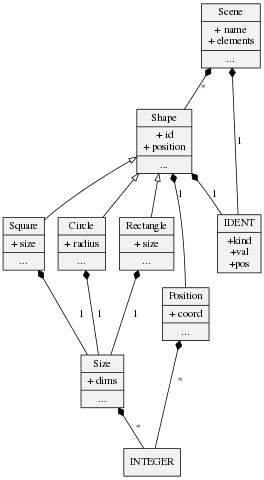
Astrapi is meta-compiler for Sexp-based Domain Specific Languages : once you have described your DSL concepts (abstract syntax) thanks to Astrapi language, the compiler generates several files for you:
Finally a driver for you own DSL compiler is also generated. Version 0.0.2 provides Ruby generation, but Python, Java and C++ will be available soon.
Astrapi-generated DSL parser will assume your DSL models are written in plain s-expressions.
S-expressions, abreviated as "sexps", actually mean "symbolic expressions". They originated from the famous LISP language. Compiler designers resort to sexp as the most direct mean to capture Abstract Syntax Trees (AST) in a textual format.
Sexps are convenient to serialize both data and code, which offers a superiority over other serialization formats like XML, YAML or JSON.
It may be noticed that several S-expressions parsers exist around. In the Ruby ecosystems, SXP and Sexpistols can be recommanded. However, these parsers will just turn the parenthesized expressions into a Ruby native data structure : namely arrays of arrays, etc. If your intent is to consider each s-expression as an instance of a custom class, then Astrapi is for you !
In your terminal, simply type : gem install astrapi
In this example, we invent a toy language (DSL) that aims at describing simple geometry. Let us begin with examples programs written in our expected syntax :
(scene test (square s1 (position 123 345) (size 12) ) (circle c1 (position 123 345) (size 12 23) ) (rectangle s2 (position 323 445) (size 12 34) ) )
Now let's express the concepts of this model : let's name this a metamodel. I suffix this file with '.mm'. It ressembles Ruby modules and class, but it is not.
module Geometry class Scene attr name => IDENT attr elements => Shape[] end class Shape attr id => IDENT attr position => Position end class Square < Shape attr size => Size end class Circle < Shape attr radius => Size end class Rectangle < Shape attr size => Size end class Size attr dims => INTEGER[] end class Position attr coord => INTEGER[] end end
Then compile this metamodel using Astrapi :
jcll$ > astrapi geometry.mm ASTRAPI meta-compiler for Sexp-based DSLs (c) J-C Le Lann 2016 ==> parsing metamodel.................... geometry.mm ==> pretty print metamodel............... geometry_pp.mm ==> generate dot for metamodel........... geometry_ast.dot ==> checking metamodel ==> generating class diagram............. geometry_class_diagram.dot ==> generate software stack for DSL 'Geometry'. Ruby version ----> generating Geometry DSL AST classes ----> generating Geometry DSL AST printer ----> generating Geometry DSL lexer ----> generating Geometry DSL parser ----> generating Geometry DSL pretty printer ----> generating Geometry DSL compiler
Now we can play with our brand new Geometry compiler !
$> ruby geometry_compiler.rb ex1.geo Geometry compiler ==> parsing ex1.geo ==> pretty print to ........ ex1.geo_pp.geometry ==> generate dot for AST in ex1.geo.dot compiled in : 0.001463371 s
In particular, we can have a look at the graphical AST (plain graphiz dot format). If you have xdot installed, simply type xdot ex1.geo.dot and the AST of our example will show up like this.

Astrapi metamodel syntax remains very basic. A concept is captured as a class, followed by the list of its attributes attr. The type of the attributes appears after =>. Attributes can be simple or multiple. The order of declaration of classes has no importance, but the order of attr declarations is fundamental, as it drives the generated DSL parser. This may be enhanced in a future version.
There also exist some basic types understood by Astrapi and parsed as terminals :
Note that you can use nil in your DSL model, either for expected concepts or terminals.
A graphical view of the metamodel structure is also generated by Astrapi. This is a basic class-diagram of the AST classes. The name of the dot file appears during the metamodel compilation. It is suffix a ** xxx_ast.dot . To view it, type **xdot xxx_ast.dot. For our Geometry example :

Comments are accepted in Astrapi s-expressions. Comments starts with # symbol and ends at the end of line. A comment will be attached (attribute .comments_) to the AST node following this comment. As such, comments can be reused (code generation etc).
Please drop me an email if you use Astrapi, or want some additional features or bug fixes.